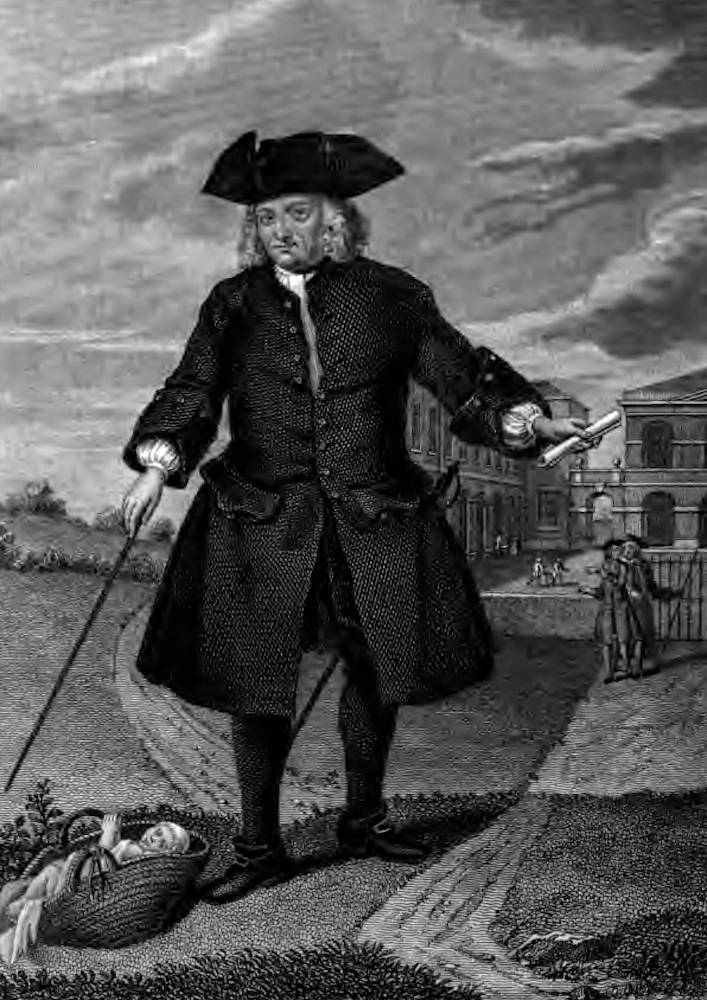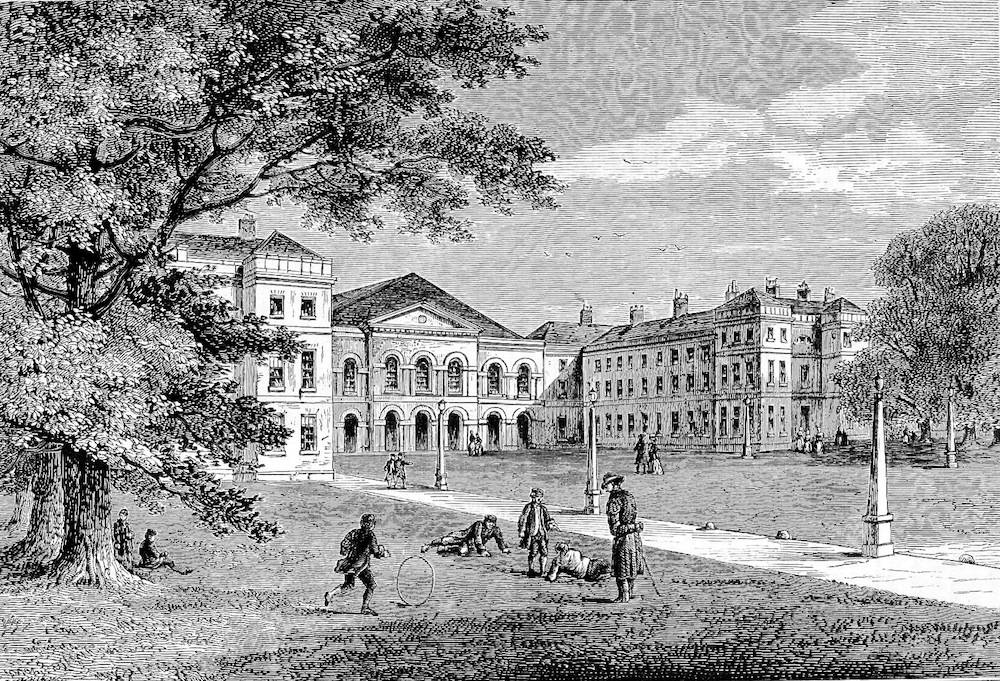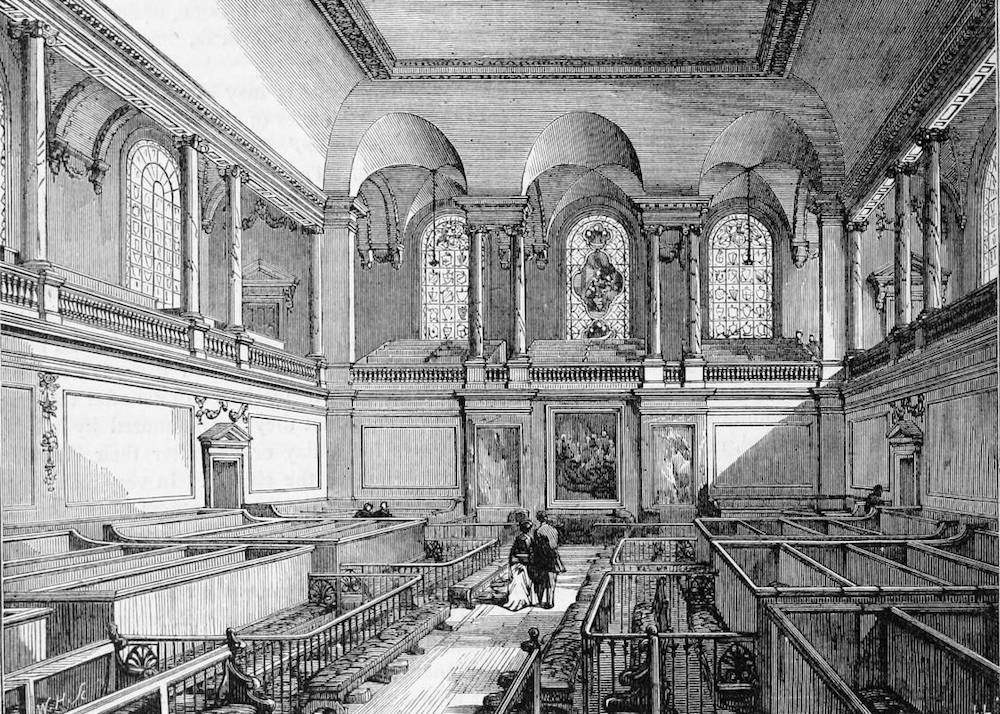
Thomas Coram, by William Hogarth (1740).
Thomas Coram (1668-1751) was born in the seaport town of Lyme Regis on the Dorset coast, where his father probably worked in the Customs House (see Wagner 11). He was sent to sea at the young age of eleven, and at sixteen was apprenticed to a ship-builder. In 1693 he was sent out to America by a London merchant, to ply his trade in New England. There he established a successful shipbuilding business of his own in nearby Taunton, marrying Eunice Waite, the daughter of a good Boston family, in 1700 (see Wagner 25). At around this time, according to one source, he was also engaged in commerce: "He became a ship-master, and acquired some property in following seas, especially in the then newly-discovered fisheries" (Brownlow 8). But his very success, and his staunch, patriotic Anglicanism in this dissenting stronghold, made him enemies, and in the end he was embroiled in disputes and physically attacked. Instead of making his fortune, he now found himself in debt. Leaving behind land for a Church of England church or schoolhouse to be built, a gesture at once generous and defiant, he returned to England with his wife. St Thomas's Episcopal Church stands in Taunton today, the third on its site, though not on the land he had actually left for it (see Compston 31-4, and "Parish History").
America still featured largely in Coram's life. He devised various projects to help ex-soldiers and others settle in America and Canada: in 1732 he was appointed one of the original trustees of the new state of Georgia (Taylor). But he was now living in Rotherhithe, in the docklands, and campaigning for something even dearer to his heart. Infants were often abandoned in this area to take their chances, and, as he walked back and forth to the city early in the morning or late at night, he regularly encountered their pitiful little bodies lying by the roadside. Although he and his wife had no children of their own, he imagined the desperation of women who were driven to what so often amounted to infanticide. The idea of a dedicated foundling hospital had earlier been advanced by the economist William Petty (1623-1687), among others (see Levene 4-5), and there were already such institutions in other major cities like Paris and Rome. Early on, Coram had the support of his own good friend, the Reverend Thomas Bray (1656-1730), better known as the founder for the SPCK, or Society for Promoting Christian Knowledge (see Zunshine 149). Practical, energetic and determined, often frustrated in his other schemes, he now poured his energy into campaigning for suitable facilities to be made available in London.
Child Abandonment

Captain Thomas Coram, from a painting of 1741 by Balthasar Nebot. Coram comes across a baby in a Moses basket, left by the roadside. The paper he holds is probably the upper-class women's petition for a foundling hospital, by now already successfully presented to the king. (Brownlow, frontispiece.)
The state had long squirmed under the burden of homeless children. One proposed solution goes back to the previous century, when the anonymous author of The Poor Orphans Court or Orphans Cry (1636) devised a plan for "Every ship that goes to Virginia to carry sixe boyes and sixe girles, every one to carry the like to New England, and to our other plantations, and the Parish to pay their passage" (n.p.). Later, hard-pressed to accommodate rising numbers of such children in the home country, the state would indeed ship out youngsters found guilty of petty crime, as well as whole batches of children "whose only crime [was] poverty" ("The Children of the Poor"). Coram himself favoured emigration at a later stage, but helpless infants needed immediate shelter. There was another special problem here — the taint of immorality, for these children were either illegitimate, or assumed to be so. Since his previous charitable schemes had often run into difficulties, Coram garnered support for a foundling hospital from as many public figures as he could — at his wife's suggestion, through appealing to their wives. In this way, he promoted the idea among those best able to practice philanthropy, and in the process strove to make such philanthropy fashionable. His campaign started in earnest around the time of the Poor Law legislation of 1722-23, which established the deterrent function of the workhouse, and ended only when George II signed and sealed a "charter of incorporation" in 1739 "for the Hospital for the Maintenance and Education of Exposed and Deserted Children" (Wagner 132). The result was the first children's charity in the country, and one that "set the pattern for incorporated associational charities" in general (McClure 248).
The Beginning

Front of the Foundling Hospital, Coram's Fields, Middlesex, designed by Theodore Jacobsen (d.1772), 1742-52 (Walford 355).
The Foundling Hospital opened in 1741 in temporary premises in Hatton Garden, off Holborn Circus, a road now, ironically, known for its jewellery shops. And from 1742-52 a grand "hospital" or home was built nearby, to the designs of Theodore Jacobsen (d.1772), on land bought from the Earl of Salisbury in the area of London still known as “Coram’s Fields.” After it was ready, six hundred children were moved there (Walford 357). Patronage continued to be of prime importance in Coram's endeavours. Famous patrons of the institution in the early days were his friends Hogarth and George Frederick Handel, both governors of the Hospital, the former a founder-governor. These men's talents would contribute greatly to its attractions. Hogarth gave his fine portrait of the Captain to the Hospital free of charge, and proposed hanging paintings in the new building to attract visitors — and, of course, to display the artists' work, and possibly win them commissions (see White 473). In this way, the Foundling Hospital served as the first public art gallery in London, and a visit to the Hospital became, and remained, "the most fashionable morning lounge of George II" (Nichols and Wray 252). In 1749, Handel gave his first benefit concert there, concluding his new Foundling Hospital Anthem with the Hallelujah Chorus from the then little known Messiah, and at the opening of the chapel in the following year, his performance of the Messiah was double booked, and had to be repeated two weeks later. This too set a pattern, and not only for the annual performances that continued for nearly twenty years after the composer's death: "What Handel began, other eminent musicians continued" (Brownlow 74). People of all sorts also flocked to the chapel for Sunday worship. In his humorous "Ballad of Eliza Davis," William Makepeace Thackeray, who came to live in Coram Street in 1837, writes in the voice of an East End policeman: "Praps you know the Fondling Chapel, / Vere the little children sings," adding in an aside, "Lor! I like to hear on Sundies, / Them there pooty little things" (161).

Interior of the Chapel of the Foundling Hospital (Walford 360). The chapel was at the very heart of the institution.
The charitable project itself was extraordinarily influential. As Ruth McClure says, Coram's greatest accomplishment was to establish a framework for this kind of enterprise — one that would be copied "by innumerable institutions towards the end of the century when Evangelical influence encouraged the growth of many organized charities" (248). There were a plethora of imitators in the next century, too, among them Mary Carpenter (1807-1877) with her institutions for destitute and erring children, Dr Barnardo (1845-1905), with his famous "village homes," and Edward de Mountjoie Rudolf (1852-1933), who founded the Waifs and Strays Society (now the Children's Society) in 1881. The 1880s in particular were "a decade of educational and philanthropic achievement," write Colin Ford and Brian Harrison (35), pointing put that from 1886-90 the Waifs and Strays Society alone "nearly quadrupled the annual sums it had raised in its first five years" (36). Coram's model was the blueprint and at least one of the inspirations for all such humanitarian organisations.
Last modified 11 May 2016